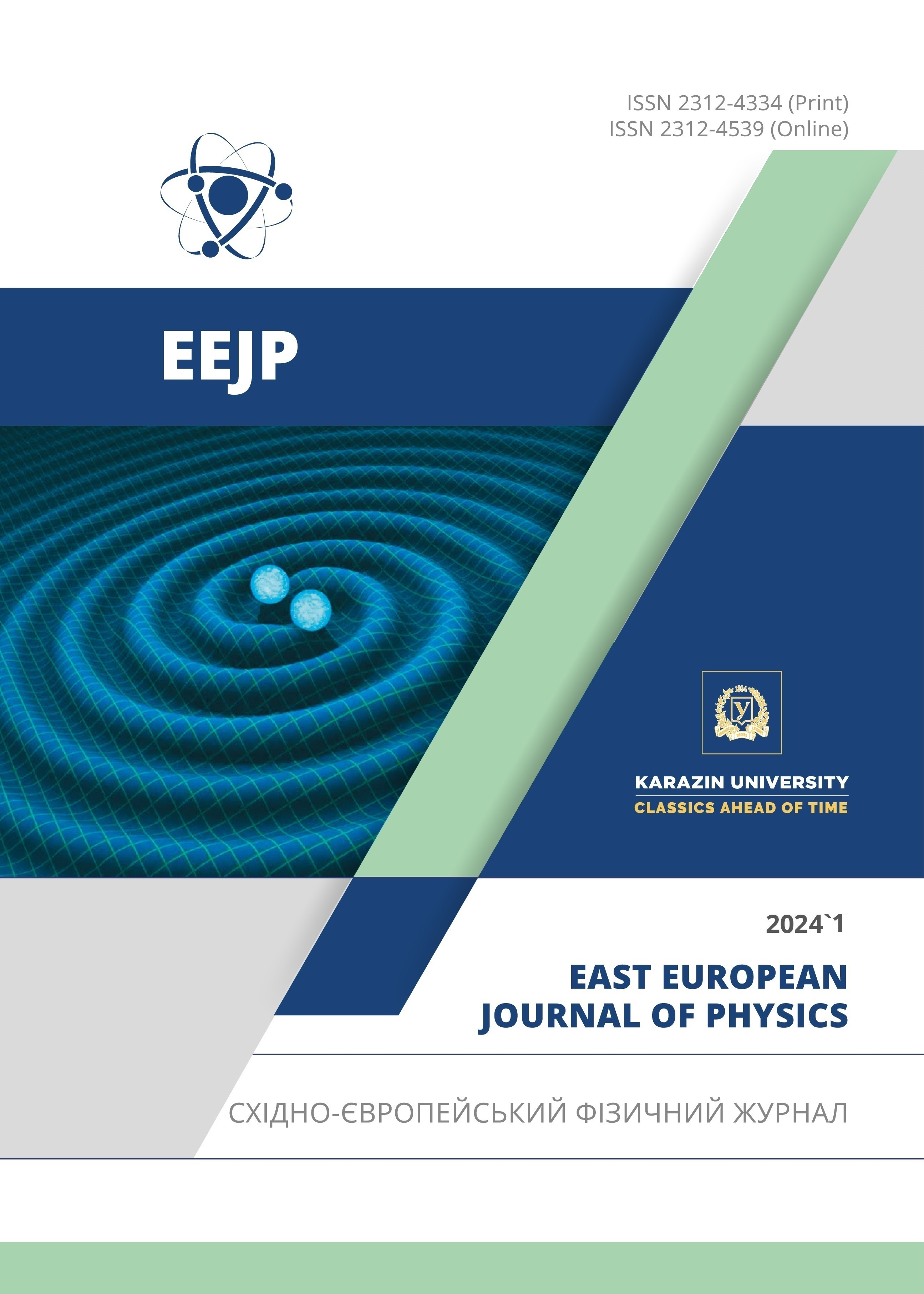Phase Formation Process in CdSe Thin Films
Abstract
In this work, thin films of cadmium selenide of difrent thicknesses were obtained by chemical deposition and the processes of phase formation in them were studied. Thin layers with a thickness of d = 150 – 500 nm were obtained. Structural studies were carried out using X-ray diffraction. The spectra obtained at room temperature were analyzed. The presence of structural features of the CdSe compound in thin layers has been established. After a thickness d = 400 nm, the process of phase formation begins. The observed atomic planes and Miller indices during the phase formation process are determined.
Downloads
References
B.G. Tagiyev, O.B. Tagiyev, A.I. Mammadov, V.X. Quang, T.G. Naghiyev, S.H. Jabarov, M.S. Leonenya, et al., “Structural and luminescence properties of CaxBa1−xGa2S4: Eu2+ chalcogenide semiconductor solid solutions,” Physica B: Condensed Matter, 478, 58-62 (2015). https://doi.org/10.1016/j.physb.2015.08.061
G.М. Аgamirzayeva, G.G. Huseynov, Y.I. Aliyev, T.T. Abdullayeva, and R.F. Novruzov, “Crystal structure and magnetıc propertıes of the compound Cu3Fe0.5Se2,” Advanced Physical Research, 5(1), 19-25 (2023). http://jomardpublishing.com/UploadFiles/Files/journals/APR/V5N1/Agamirzayeva_et_al.pdf
S.H. Jabarov, “First principles study of structural phase transition in Ag2S under high pressure,” Integrated Ferroelectrics, 230(1), 23-28 (2022). https://doi.org/10.1080/10584587.2022.2102794
A.S. Alekperov, A.O. Dashdemirov, A.E. Shumskaya, and S.H. Jabarov, “High-Temperature Exciton Photoconductivity of Ge1 xNdxS Crystals,” Crystallography Reports, 66, 1322-1327 (2021). https://doi.org/10.1134/S1063774521070026
N.A. Aliyeva, Y.I. Aliyev, and A.S. Abiyev, “Study of thermal properties of Cu4Se1.5Te0.5 and Cu4Te1.5Se0.5 compounds by differential thermal analysis,” Advanced Physical Research, 4(2), 94-99 (2022). http://jomardpublishing.com/UploadFiles/Files/journals/APR/V4N2/Aliyeva_et_al.pdf
Kh.N. Ahmadova, and S.H. Jabarov, “Obtaining of Al nanosized thin layers and their structural properties,” Arabian Journal for Science and Engineering, 48, 8083-8088 (2023). https://doi.org/10.1007/s13369-022-07449-2
E.Sh. Alekperov, S.G. Jabarov, T.A. Darzieva, G.B. Ibragimov, A.M. Nazarov, and S.S. Farzaliev, “Effect of an electric field on the crystallization behavior of amorphous TlIn1-xSnxSe2 films,” Inorganic Materials, 59(1), 8-11 (2023). https://doi.org/10.1134/S0020168523010028
N.N. Mursakulov, N.N. Abdulzade, S.H. Jabarov, and Ch.E. Sabzalieva, “Investigation of CuIn1-xGaxSe2 thin films for solar cells obtained by the magnetron sputtering method from two magnetrons shifted to each other,” New Materials, Compounds and Applications, 6(2), 140-147 (2022). http://www.jomardpublishing.com/UploadFiles/Files/journals/NMCA/v6n2/Mursakulov_et_al.pdf
R.S. Madatov, A.S. Alekperov, and A.E. Nabiyev, “Influence of Sm impurity atoms on the switching effect in thin films of GeS,” Izvestiya of Saratov University. Physics, 16(4), 212-217 (2016).
A.O. Dashdemirov, “Thermal emission properties of Re-C thin film systems,” Advanced Physical Research, 2(2), 102-107 (2020). http://jomardpublishing.com/UploadFiles/Files/journals/APR/V2N2/Dashdemirov.pdf
D.M. Freik, L.I. Nykyruy, T.O. Parashchuk, and B.P. Volochanska, “Thermodynamic properties of CDSE crystals using first principles calculations and experiment,” International Journal of Engineering and Innovative Technology (IJEIT), 4(2), 99 104 (2014). https://www.ijeit.com/Vol%204/Issue%202/IJEIT1412201408_19.pdf
Y.N. Xu, and W.Y. Ching, “Electronic, optical, and structural properties of some wurtzite crystals,” Physical Review B, 48, 4335-4351 (1993). https://doi.org/10.1103/PhysRevB.48.4335
C. Li, F. Wang, and Y. Chen, “Characterization of sputtered CdSe thin films as the window layer for CdTe solar cells,” Materials Science in Semiconductor Processing, 83, 89-95 (2018). https://doi.org/10.1016/j.mssp.2018.04.022
C.D. Lokhande, E.-H. Lee, K.-D. Jung, and O.S. Joo, “Ammonia-free chemical bath method for deposition of microcrystalline cadmium selenide films,” Materials Chemistry and Physics, 91, 200-204 (2005). https://doi.org/10.1016/j.matchemphys.2004.11.014
S. Wageh, “Raman and photoluminescence study of CdSe nanoparticles capped with a bifunctional molecule,” Physica E: Low Dimensional Systems and Nanostructures, 39, 8-14 (2007). https://doi.org/10.1016/j.physe.2006.12.003
R.A. Potyrailo, and A.M. Leach, “Selective gas nanosensors with multisize CdSe nanocrystal/polymer composite films and dynamic pattern recognition,” Applied Physics Letters, 88, 134110 (2006). https://doi.org/10.1063/1.2190272
F. Li, W.-N. Li, S.-Y. Fu, and H.-M. Xiao, “Formulating CdSe quantum dots for white light-emitting diodes with high color rendering index,” Journal of Alloys and Compounds, 647, 837-843 (2015). https://doi.org/10.1016/j.jallcom.2015.05.232
X. Dai, Z. Zhang, Y. Jin, Y. Niu, H. Cao, X. Liang, L. Chen, et al., “Solution-processed, high-performance light-emitting diodes based on quantum dots,” Nature, 515, 96-99 (2014). https://doi.org/10.1038/nature13829
F.Y. Gan, and I. Shih, “Preparation of thin-film transistors with chemical bath deposited CdSe and CdS thin films,” IEEE Transactions on Electron Devices, 49(1), 15-18 (2002). https://doi.org/10.1109/16.974742
A. Kubacka, M. Fernández-García, and G. Colón, “Advanced nanoarchitectures for solar photocatalytic applications,” Chemical Reviews, 112, 1555-1614 (2012). https://doi.org/10.1021/cr100454n
A. Singh, A. Kunwar, and M.C. Rath, “L-cysteine capped CdSe quantum dots syntesized by photochemical route,” Journal of Nanoscience and Nanotechnology, 18, 3419-3426 (2017). https://doi.org/10.1166/jnn.2018.14687
Copyright (c) 2024 L.N. Ibrahimova, N.M. Abdullayev, M.E. Aliyev, G.A. Garashova, Y.I. Aliyev

This work is licensed under a Creative Commons Attribution 4.0 International License.
Authors who publish with this journal agree to the following terms:
- Authors retain copyright and grant the journal right of first publication with the work simultaneously licensed under a Creative Commons Attribution License that allows others to share the work with an acknowledgment of the work's authorship and initial publication in this journal.
- Authors are able to enter into separate, additional contractual arrangements for the non-exclusive distribution of the journal's published version of the work (e.g., post it to an institutional repository or publish it in a book), with an acknowledgment of its initial publication in this journal.
- Authors are permitted and encouraged to post their work online (e.g., in institutional repositories or on their website) prior to and during the submission process, as it can lead to productive exchanges, as well as earlier and greater citation of published work (See The Effect of Open Access).








